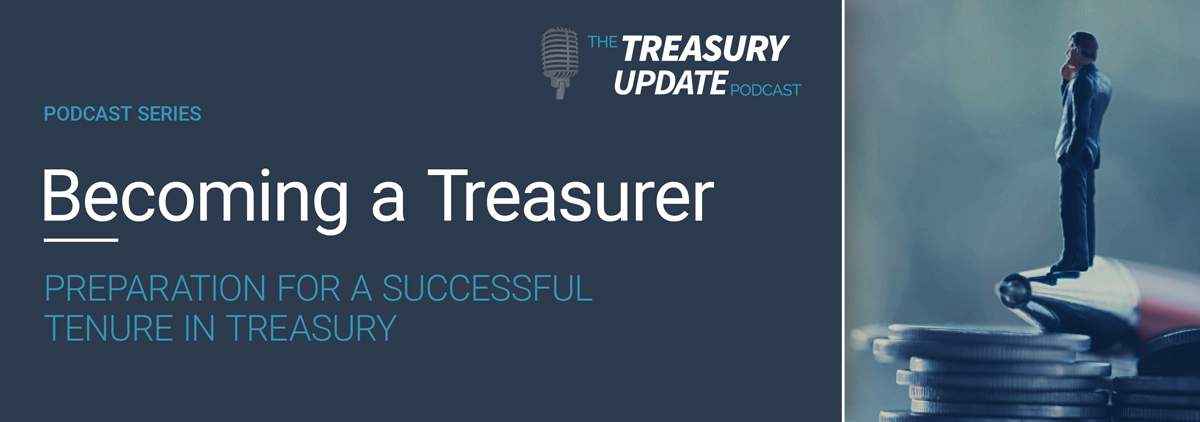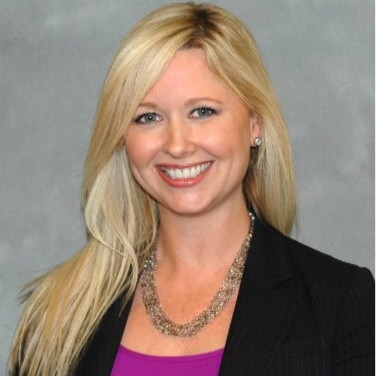
Episode 132
Becoming a Treasurer: Part 15 – Learning from Literature: Use Momentum. Challenge Linear Thinking.
On this episode of the Becoming a Treasurer series, Craig Jeffery continues the Learning from Literature sub-series, showcasing Laura Ingalls Wilder’s Farmer Boy. This illustration covers creative ways to use momentum and challenge linear thinking with view to treasury processes and general life lessons. Listen in and enjoy the entire series.
Host:
Meredith Zonsius, Strategic Treasurer


Speaker:
Craig Jeffery, Strategic Treasurer


Episode Transcription - Part 7: Adaptation and Overcoming Blind Spots (Becoming a Treasurer Series)
Meredith:
Welcome to the Treasury Update Podcast, presented by Strategic Treasurer, your source for interesting treasury news, analysis and insights; in your car, at the gym, or wherever you decide to tune in.
Meredith:
On this episode of the Becoming A Treasurer series, Craig Jeffrey continues the learning from literature subseries, showcasing Laura Ingalls Wilder’s Farmer Boy. This illustration covers creative ways to use momentum and challenge linear thinking. Listen in and enjoy the entire series.
Meredith:
Welcome to the show, Craig.
Craig Jeffery:
Thanks, Meredith.
Meredith:
So what is the book for this episode?
Craig Jeffery:
So we’re looking at Farmer Boy. It’s part of the series of the Little House on the Prairie series by Laura Ingalls Wilder.
Meredith:
Little House on the Prairie series. Did you get this from reading it to your kids?
Craig Jeffery:
No, though my kids have heard it read. I’ve read portions of it. My wife has done a better job at that. But I remember this series. My mother read it to me and some of the other kids in my family growing up. And this book in particular, there’s a lot that stuck with me on it.
Meredith:
Fun. I know it’s a classic. Give us the scene for this episode of Learning From Literature.
Craig Jeffery:
Well, if the title is called Use Momentum, Challenge Linear Thinking, if that’s the podcast title, this is the … It’s one of the middle chapters about shearing the sheep. So I think the chapter is called something like Time To Shear The Sheep, or Sheep Shearing Time. This is where they’re taking the sheep, they’re soaping them up, they’re washing them in this fast moving river, they make sure they get dried in the sun, and then they shear the sheep and they bundle the fleece up and carry it up into their barn. And so that’s the scene. It’s that once a year time, or that time of year where they clean, shear and bundle that up for later sale.
Meredith:
Do you have a sample from the book that you can share with us?
Craig Jeffery:
In this Time To Shear The Sheep, a couple of things I thought were interesting, if we talk about learning from literature. Two of the concepts here are use momentum and challenge linear thinking. And when it was time to shear the sheep, I really liked how they described … They took advantage of the sheep. They would feed them into the area, they’d get them wet, they would soak them up and then they would hold them in this fast moving river, which would get them all clean very quickly, and then they’d released them into the field, they‘d run around. The sun would beat down on them and dry them, so the fleece would be clean for when they did that. So that was the initial part of the scene, and that’s that concept of using momentum or, more modern slang, going with the flow.
Craig Jeffery:
Yeah, I’ll talk through the story. I don’t have the book in front of me. I have a couple notes, so hopefully I’ll get the quotes right. But Almanzo is farmer boy. I think he’s the one that marries our key person in the series that takes place. So Almanzo, they’re doing the sheep shearing, and it says, “He ran upstairs and down again, as fast as he could, but another fleece was always ready for him.” So they’d cut the fleece and he’d run it up. He could carry one up the stairs to the barn at a time. And then he gets distracted. I think he’s chasing a cat and seeing its nest of babies.
Craig Jeffery:
And he comes back later, and like many parents, they might have a different reaction when they see someone who hasn’t been focused on their work, particularly if it’s their kid. And he gets back there, there were six fleeces waiting for him, and his dad gives him this scolding or a stern talking to. And so he upbraids him a bit and says, “See to it that you keep up.” Well, somebody else who’s helping the father shear the sheep says, “He can’t do it.” And then, “We’ll be through before you are.” And this is said to Almanzo, and so he gets a little bit … responds to that. And Almanzo says, “You wait and see. I’m going to beat you. You wait and see.” And they all laughed.
Craig Jeffery:
And then by the time they got to lunchtime, Royal, who was one of the other people in the story, he tied up the last fleece, dropped it on the ground, or got it ready, and then Almanzo had to carry it up. There’s point of recognition at that point, and I’ll explain that in a minute. But then towards the end of the day, Almanzo is running back and forth as quick as he can, bringing the fleeces up, and they kept challenging him, “Hurry up, or we’ll beat you! We’ll be done first.” And they keep egging him on, and he’s going as quick as he can. And then they say, “We’re all through. We beat you.” And Almanzo responds, “No, you haven’t beat me. I have a fleece upstairs that you haven’t sheared. I beat you. I beat you.” And his father howls. He who laughs last laughs best. And his father loved what the story was and how it took a turn. What had happened was Almanzo had realized at lunchtime what had gone on and he took a sheep upstairs. He put a leash on it and brought it upstairs, put some food with it so it wouldn’t make a lot of noise, so it’d stay quiet. So this is the scene.
Meredith:
Break down the learning process and Almanzo’s head for us.
Craig Jeffery:
Yeah. So some of it … I mean, these stories are great. Laura Ingalls Wilder tells really, really good stories. And if you ever go to South Dakota, you’ll probably want to stop by the house and where the school yard was and see that. This initial reaction of, “You wait and see. I’m going to get done before you,” is this boasting without really thinking through the process. So he responds to the challenge of his brothers and other workers and perhaps his father, “You wait and see,” and they laughed. Almanzo wasn’t understanding the dependencies at that point or the critical path, but the others did. They understood you can’t put the fleece up into the barn until it’s bundled and you can’t bundle it until it’s cut. And so we’re going to be done with the bundling before you can carry it up. There’s no way you can finish before that. And so they understood the dependencies. He did not.
Craig Jeffery:
But Almanzo obviously reacted to their challenge. But when it was lunchtime, it was kind of like a mini end of the day for him. And he realized, I think at that point, he understood the dependencies and a linear process. If something occurs after something, I have to transport it to the area, that’s a problem. So this is when the light went on in his head. He’s like, “I’m not going to be able to finish before they’re done because I still have to transport it.” And that’s where he figures out a way, “How do I change the order? How do I change where these things are located? And if I put the sheep up, that when the fleece is done, it’s in the final spot, I’ve flipped how things work and I will be done first?”
Craig Jeffery:
So I think that’s the key part there, and so he’s running … He also made sure to keep his pride intact, that he fed it, so they wouldn’t say, “You’re not supposed to bring sheep up into the barn,” or whatever somebody could say. So I think that was the learning of Almanzo.
Meredith:
Making an efficient process.
Craig Jeffery:
Yeah, we’re just thinking of it differently. But I don’t know that it was super efficient to bring the sheep upstairs in this case, and how long it took. But he also was saying … There’s a sense of, “Hey, this happens after this, after this, after this.”
Meredith:
Right, right. He made his point. How do we apply this to treasury?
Craig Jeffery:
Well, I think there’s a couple things. One, this is a story from literature, so there’s general life lessons on it. But in terms of treasury, when we think about treasury processes, or as we think about thinking, we don’t always have to believe linear thinking about how things are done or what’s the order. And this can be in a regular workflow, it can be broken down processes, it can be related with slack.
Craig Jeffery:
So, for example … Well, I won’t give too many examples here, but you just think of in this work from home environment, in the COVID time, people, they would sign documents and they would move physical documents that were related to moving funds, batches of transfers, ACH or other, or it might be approving a wire transfer. And sometimes those signature approvals are done after the fact, sometimes there’s this … Here’s a piece of paper that has to be signed and we have to wait until it’s signed and then move physically over somewhere else.
Craig Jeffery:
But when you think about how do we change that process, how do we put the sheep where the fleece goes, how do we shorten that, it might be, “Hey, I want the approval process baked into the system so that when someone approves it, it’s instantly there digitally.” And this is part of the promise of digitalization. It’s like, “I approve it.” Now the system knows it, it’s inherited that approval, and so the process can continue. We don’t have to have transport of physical documents. Even if it’s like, I sign it, I scan it, I email it; those are all lots of steps, points of breakdown, points of delay. And so that might be one example of putting the sheep where the fleece has to go.
Craig Jeffery:
But of course, there’s lots of examples. And I think that the key thing here is … In this story, there’s the two things, the two parts, Meredith. It’s don’t always think of things in the order that they’ve been, and think creatively. And I like how like Almanzo was pressed and then he saw the difference and then he figured a way around it. And his father’s reaction is awesome. It’s like, “That’s the way to think, son. Think differently.”
Meredith:
Yeah, great problem solving. Craig, I love how you provide treasury insights through this Learning From Literature series. I’m looking forward to discussing some more of these this year. Do you have anything else in mind at this point?
Craig Jeffery:
A couple more in the queue. I’m not going to give any early, early warnings about those, but they might not always be children’s stories, but I do. Some of those have influenced my thinking my entire life. And as you get to read them again, it’s very, very interesting to just think about thinking and understand how people react and manage those differences. So I know this one was light on treasury and much heavier on the story part, but perhaps that’ll broaden our audience to those that are non-treasury professionals.
Meredith:
I love it. I love it. Thanks for sharing, Craig.
OUTRO:
You’ve reached the end of another episode of the Treasury Update Podcast. Be sure to follow the Strategic Treasurer on LinkedIn. Just search for Strategic Treasurer. This podcast is provided for informational purposes only, and statements made by Strategic Treasurer, LLC on this podcast are not intended as legal, business, consulting or tax advice. For more information, visit and bookmark strategictreasurer.com.
Related Resources
#TreasuryFAQ – YouTube Playlist
Check out our YouTube playlist covering many frequently asked questions in treasury!
Becoming a Treasurer – A Treasury Update Podcast Series
This series within The Treasury Update Podcast explores questions around being a successful treasurer. Topics discussed include preparation, what needs to be measured, effective communication, development of a team, and acquirement of resources needed.



